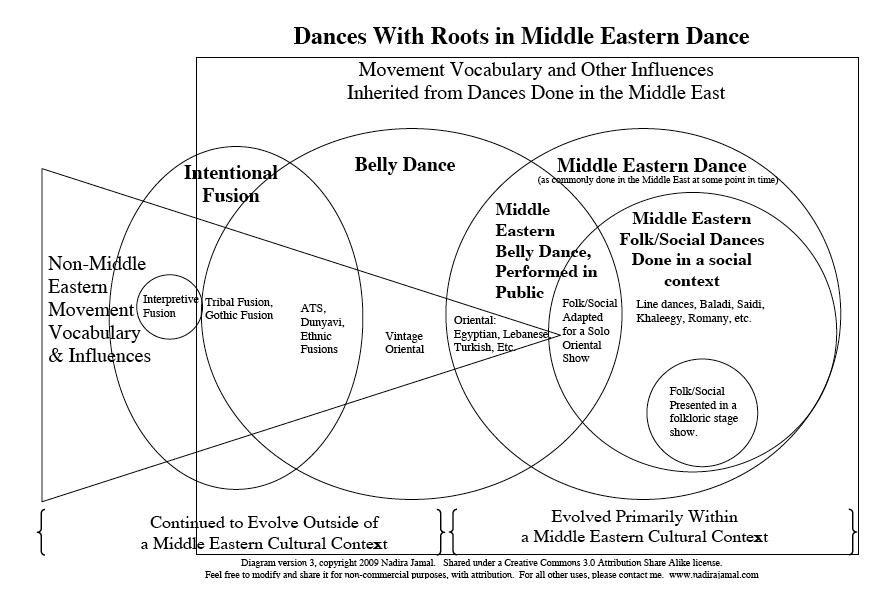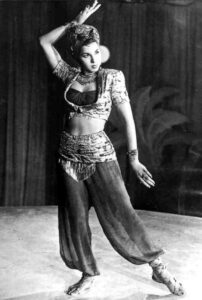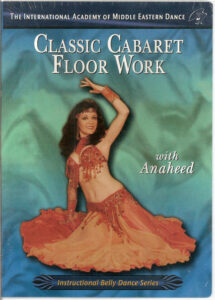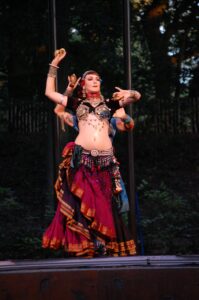Are there different belly dance styles? I thought it was all ‘belly dance’! People often assume there is only one style of belly dance. Like most things, there’s more beyond the surface once you start looking. In a previous blog post, I explored the idea of ‘What Is Belly Dance?‘. In this post, you will learn about the different styles of belly dance and how they relate to each other. I hope this will help you as a student inform which styles of belly dance you would like to learn.
Relationships Between Belly Dance Styles
In my previous post, I suggested that belly dance is “all about expressing music through movement using isolation and articulation of the torso, chest, and hips”. All belly dance shares this common movement vocabulary and expressivity, but it has evolved in multiple directions from its Middle Eastern origins to become different styles. Jess Reed (Nadira Jamal) created a diagram which sums it up quite nicely: all the various interconnected influences and styles which fall under the ‘belly dance’ umbrella.

Middle Eastern Belly Dance
Belly dance originally evolved in a Middle Eastern cultural context, with influences from within and outside the Middle East. Within this Middle Eastern cultural context, belly dance was influenced by Middle Eastern social dances, for example by incorporating a saidi (stick) style originating in Upper Egypt into the solo oriental dance show. Middle Eastern belly dance has also been influenced by styles outside the Middle East. Samia Gamal (a famous Egyptian belly dancer from the 1940s and 1950s) was trained in ballet as well as belly dance and incorporated ballet technique, such as travelling steps and expressive hands and arms, into her belly dance. She also pioneered the use of a veil as a prop in belly dance at the suggestion of her Russian ballet teacher in order to make her arms appear more graceful.

Middle Eastern style belly dance is not homogenous, with different local flavours depending on the location. Turkish and Egyptian styles are the two most prominent. Generally, the dance is performed to Arabic-language music (and Turkish language in Turkey), to well-loved classics and current popular hits. The dance moves tend to focus on the hips, with isolated, layered movements driven by the torso muscles. There are several differences between the Turkish and Egyptian styles, the principal one being that Turkish style is livelier and more energetic, while the Egyptian style is more contained.
American Influences on Belly Dance
From the Middle East, belly dance spread widely with the post-war emigration of people from the Middle East. In the USA, a large diaspora community set up restaurants and nightclubs which featured belly dance performances. These catered to both immigrant audiences and Americans seeking exotic food and entertainment. These are the roots of the ‘American Cabaret’ or ‘Vintage Orientale’ style, featuring showy and dramatic movements, a variety of props including finger cymbals and veil, floor work, and music from all over the Middle East, all intended to entertain an American audience.

Fusion Belly Dance
After the arrival of belly dance in the USA, dancers began blending it with aesthetics, music, and movements from a variety of genres to create new fusion styles. Jamila Salimpour with her troupe Bal Anat was the first – she was inspired by circus variety shows, Middle Eastern style belly dance, and folkloric dances and aesthetics from the Middle East and North Africa to create a new fusion style (“From Many Tribes, The Origins of Bal Anat” by Jamila Salimpour). From these roots grew the ‘American Tribal Style’, a group improvisation style with earthy aesthetics, performed to folkloric-style music usually featuring Middle Eastern rhythms and sometimes fused with Western electronica sounds.

The fusion belly dance tree has branched from American Tribal Style to take in influences in movement and music from across the globe. There are no set movements, music, or aesthetics in fusion belly dance. Belly dance has been fused with electronica, ballet, hip-hop, yoga, metal, contemporary dance, flamenco, jazz, hula, …. and more. There are complex ethical issues in transnational fusion dance, for example the term ‘tribal’ has been recognised as inappropriate to describe styles of the fusion dance community (Donna Mejia blog). However, gathering and fusing diverse inspirations to create new art forms is a natural human behaviour, and when done respectfully and intentionally, can create spectacular new belly dance styles.
As a student of belly dance, ask yourself, what style of belly dance do I do (or would I like to learn)? What other forms of movement and music do I draw inspiration from? How do I fuse my unique inspirations to create my own style within my chosen belly dance genre (transnational fusion, Middle Eastern, …)? Keep learning, experimenting, fusing, and dancing!
Further Reading
Shira’s styles of belly dance used in the United States. http://www.shira.net/styles.htm
Donna Mejia’s resources on transnational fusion. https://donnainthedance.com/resources/
Farida Fahmy’s articles. See especially “Egyptian Dance Aesthetics for Bellydancers”. http://www.faridafahmy.com/articles.html
